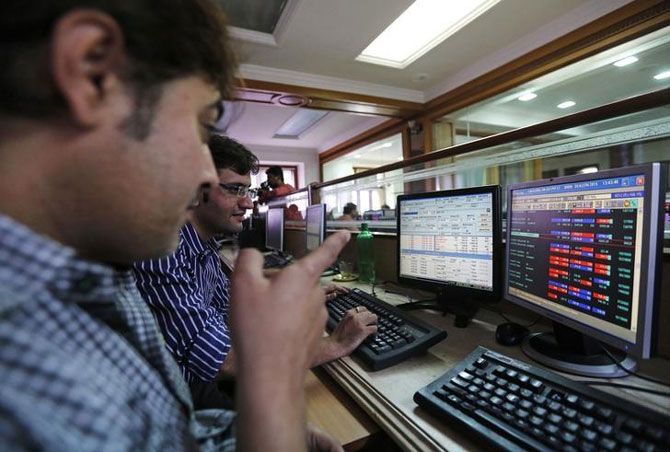A falling rupee and lower foreign buying in equities are signals investors should watch out for, says Devangshu Datta.

When money is available at low cost, rational investors will invest until there's nothing left to invest in. The risk profile of all investments will rise. This is one reason why bubbles develop.
Crashes happen when money becomes more expensive or there are no investment avenues.
Once a crash occurs, policymakers tend to loosen money supply again to encourage activity. This happened after the global crash of 2007-08. It worked in the sense that the extra liquidity prevented a full-fledged depression.
But, the quantitative easing (QEs) run by various central banks sets up new incentives for risk-taking.
The post-2007 experience also indicates excess liquidity heads into secondary financial assets (already existing instruments), rather than into promoting new businesses.
It also seems recovery is a long-drawn process with likely hiccups, given the follow-up crises, which occurred.
Ten years later, Europe and Japan are finally seeing some growth.
The US recovered earlier but it's not been a very strong recovery. Big central banks have maintained low interest rates and high money supply since 2007.
The European Central Bank (ECB), Japan, and several other central banks in Europe have negative interest rates and ongoing QEs.
Debt yields in the First World are negative or very low.
Given the cheap money, foreign portfolio investors (FPIs) continue to take on risky investments in search of higher returns.
India offers an opportunity for investors with hard currency funds available at near-zero cost.
Indian government debt has yields of seven per cent-plus. Given a strong rupee and low inflation, real returns are high. Even where equity valuations are concerned, FPIs may consider very high PEs justifiable.
In 2016-17, FPIs invested a net Rs 48,411 crore, with a net buy of Rs 55,703 crore of equity and net sales of Rs 7,292 crore of debt.
In 2017-18 (until September 15, 2017), FPIs have invested a net Rs 102,697 crore in debt and Rs 1,374 crore in equity.
The preference-switch to debt could mean they are betting on more rate cuts.
High net investments by them may continue until one, or more, of several events occurs.
For one, the rupee could weaken sharply, setting up currency risks.
Two, interest rates may rise in Europe, Japan and the US, making funds more expensive.
Three, other emerging markets may become more attractive.
The rupee exchange rate has been buoyed by the FPI inflows. India's exports are weak, imports are high and the fiscal deficit is likely to expand.
These negatives could impact the rupee and push it down some time.
The US Federal Reserve has signalled it is prepared to raise rates over the next year, and it will sell off the bonds it acquired during QEs, decreasing money supply in the bargain.
The ECB is considering tapering its own ongoing QE. Given economic expansion, the EU could see inflation sometime in the future.
In comparative terms, India is now the most highly valued of emerging markets and growth has slowed.
The East Asian 'Tigers' in contrast, are seeing export growth linked to global recovery. Investors are also eyeing policy risks in India, given many assembly elections in 2018 and accompanying loan waivers.
As the data indicate, FPIs have cooled off on equity. So far in this financial year (April-mid-September), the average net equity buying was Rs 250 crore a month, compared to an average of Rs 4,600 crore through the last financial year.
The bull run has continued because domestic retail has stepped up, buying equity directly and via mutual funds.
All three negative factors could come into play over the next few quarters. A net hike in hard currency interest rates seems guaranteed.
An expansion of India's fiscal deficit is almost guaranteed, as 90 per cent of the annual budgeted fiscal was hit in the April-June quarter itself.
Look for the twin signals of a falling rupee coupled to lower FPI equity buying, or active FPI equity selling.
Track FPI-driven stocks.
As and when these signals arise, deep corrections could occur in those scrips.
At the first stage, that correction will offer opportunities for traders to go short in the futures segment.
In the longer-term, those stocks should hit lower valuations that attract investors.
Photograph: Reuters.












 © 2025
© 2025